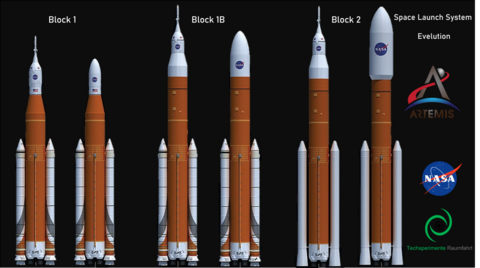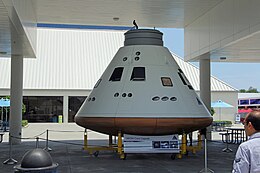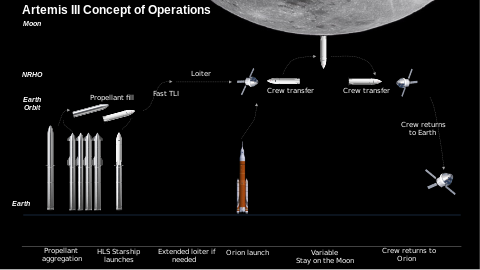


Summary of the Artemis 3 mission plan
| |
| Names | Exploration Mission-3 (2017–2019) |
|---|---|
| Mission type | Crewed lunar landing |
| Operator | NASA |
| Mission duration | ~30 days[1] |
| Spacecraft properties | |
| Spacecraft | Orion 004 Starship HLS |
| Manufacturer |
|
| Start of mission | |
| Launch date | September 2026 (planned)[4] |
| Rocket | SLS Block 1 (Orion)[5] |
| Launch site | Kennedy Space Center, LC-39B |
| Contractor | NASA |
| End of mission | |
| Landing site | Pacific Ocean (planned) |
| Moon lander | |
| Landing site | South polar region |
Artemis 3 (officially Artemis III)[6] is planned to be the first crewed Moon landing mission of the Artemis program and the first crewed flight of the Starship HLS lander.[7] Artemis 3 is planned to be the second crewed Artemis mission and the first American crewed lunar landing since Apollo 17 in December 1972.[8] In December 2023, the Government Accountability Office reported that the mission is not likely to occur before 2027;[9] as of January 2024, NASA officially expects Artemis 3 to launch no earlier than September 2026 due to issues with the valves in Orion's life support system.[4][10]
In August 2023, due to delays in the development of Starship, NASA officials expressed an openness to flying Artemis 3 without a crewed landing.[11][12] In this case, the mission may become a crewed visit to the Lunar Gateway.[13] In April 2024, it was reported that alternative mission options being internally evaluated by NASA include a test of docking between Orion and Starship HLS in low earth orbit.[14]
The goal of Artemis 3 is to land a crew at the Moon's south polar region.[15] The mission would see two astronauts land on the surface of the Moon for a stay of about one week.[16] It is also intended to be the first mission to land a woman and a person of color on the Moon.[17][18] While up to four astronauts would launch aboard Orion, only two would land on the surface aboard Starship HLS, with the others remaining aboard Orion. The two astronauts will conduct up to four spacewalks on the Moon's surface, performing a variety of scientific observations, including sampling water ice. Before the Artemis 3 landing, some additional equipment will be pre-positioned on the surface, including an unpressurized rover for astronauts to use during their lunar excursions. This rover will have the capability to be controlled remotely. Several permanently shadowed regions could be reached by short forays of 5 to 15 km (3.1 to 9.3 mi), well within the range of the rover.[19]
| Position | Astronaut | |
|---|---|---|
| Commander | TBA, NASA TBA spaceflight | |
| Pilot | TBA, NASA TBA spaceflight | |
| Payload Specialist | TBA, NASA TBA spaceflight | |
| Mission Specialist | TBA, NASA TBA spaceflight | |

The Space Launch System is a super-heavy-lift launcher used to launch the Orion spacecraft from Earth to a trans-lunar orbit. This will be the final mission using the booster SLS Block 1, the design used for the first three missions. Afterward, from Artemis 4 until Artemis 8, missions will use SLS Block 1B, with a more capable Exploration Upper Stage, and a cargo hold to transport other payloads.

Orion is the crew transport vehicle used by all Artemis missions. It will transport the crew from Earth to lunar orbit, dock with Starship HLS, and return the crew to Earth.

After a multi-phase design effort, on 16 April 2021, NASA selected SpaceX to develop Starship HLS and deliver it to near-rectilinear halo orbit (NRHO) prior to arrival of the crew for use on the Artemis 3 mission. The delivery requires that Starship HLS be refueled in Earth orbit before boosting to the NRHO, and this refueling requires a pre-positioned propellant depot in Earth orbit that is filled by multiple (at least 14[20]) tanker flights.[21] Two astronauts will transfer from Orion to Starship HLS, which will descend to the lunar surface and sustain them for several days before returning them to Orion. Following the return of the astronauts, Starship HLS will be disposed of by sending it into heliocentric orbit.[22]
Upon the December 2017 ratification of the Trump administration's Space Policy Directive 1, a crewed lunar campaign – later known as the Artemis program – using the Orion Multi-Purpose Crew Vehicle (MPCV) and a space station in lunar orbit was established. Originally billed as Exploration Mission-3 (EM-3), the goal of the mission was to send four astronauts into a near-rectilinear halo orbit around the Moon and deliver the ESPRIT and U.S. Utilization Module to the lunar space station, known as the Gateway.[23] By May 2019 however, ESPRIT and the U.S. Utilization Module – now called HALO – were re-manifested to fly separately on a commercial launch vehicle. Artemis 3, as it was now billed, was repurposed to accelerate the first crewed lunar landing of the Artemis program by the end of 2024, with a profile that would have seen the Orion MPCV rendezvous with a minimal Gateway space station made up of only the Power and Propulsion Element and a small habitat/docking node with an attached commercially-procured lunar lander known as the Human Landing System (HLS).[24]
By early 2020, plans for Orion and the HLS to rendezvous with the Gateway were abandoned in favour of direct docking of Orion and HLS, and delivery of the Gateway after Artemis 3.[25][26]
On 10 August 2021, an Office of Inspector General audit reported a conclusion that the spacesuits would not be ready until April 2025 at the earliest, likely delaying the mission from the planned late 2024 launch date.[27] Prada, alongside Axiom Space, will help design the space suits.[28]
On 9 November 2021, the Administrator of NASA, Bill Nelson, confirmed that Artemis 3 will launch no earlier than 2025.[29]
In June 2023, Jim Free, NASA's associate administrator for exploration systems development, said that launch would "probably" be no earlier than 2026.[30][31] Later in December 2023, the GAO reported the mission was unlikely to occur before 2027.[9]
In January 2024, NASA officially delayed Artemis 3 to no earlier than September 2026.[4]
On its third test flight Starship reached its desired orbital trajectory for the first time on March 14, 2024.
In March 2024, NASA announced the scientific instruments to be included on the mission were a compact, autonomous seismometer suite called the Lunar Environment Monitoring Station, or LEMS. LEMS will characterize the regional structure of the moon's crust and mantle to inform the development of lunar formation and evolution models. Another instrument is Lunar Effects on Agricultural Flora, a.k.a. LEAF, which will investigate the impact of the lunar surface environment on space crops. The third instrument is the Lunar Dielectric Analyzer, or LDA, an internationally contributed payload that will measure the regolith's ability to propagate an electric field.[32]
MISSION NAMING CONVENTION. While Apollo mission patches used numbers and roman numerals throughout the program, Artemis mission names will use a roman numeral convention.
Under the NASA plan, a mission to land on the Moon would take place during the third launch of the Space Launch System. Astronauts, including the first woman to walk on the Moon, Jim Bridenstine said, would first stop at the orbiting lunar outpost. They would then take a lander to the surface near its south pole, where frozen water exists within the craters.
NASA has removed the Lunar Gateway from its "critical path" to return humans to the Moon by 2024, according to a SpaceNews report.
... Loverro reiterated previous statements that the Gateway will not be used for the Artemis 3 mission that will attempt to land humans on the Moon to "make that mission have a higher probability of success".
... the suits would not be ready for flight until April 2025 at the earliest ... a lunar landing in late 2024 as NASA currently plans is not feasible.
|
| ||||||
|---|---|---|---|---|---|---|
| ||||||
| Missions |
| |||||
| Agencies |
| |||||
| Facilities |
| |||||
| Rockets |
| |||||
| Crewed spacecraft |
| |||||
| Robotic spacecraft |
| |||||
| ||||||
|
| |||||||
|---|---|---|---|---|---|---|---|
| Components |
| ||||||
| Programs |
| ||||||
| Launch vehicles |
| ||||||
| Precursors or Cancelled |
| ||||||
| Missions |
| ||||||
| |||||||
|
Future spaceflights
| |||||||||||||
|---|---|---|---|---|---|---|---|---|---|---|---|---|---|
| Crewed |
| ||||||||||||
| Uncrewed |
| ||||||||||||
| Recently launched |
| ||||||||||||
| |||||||||||||